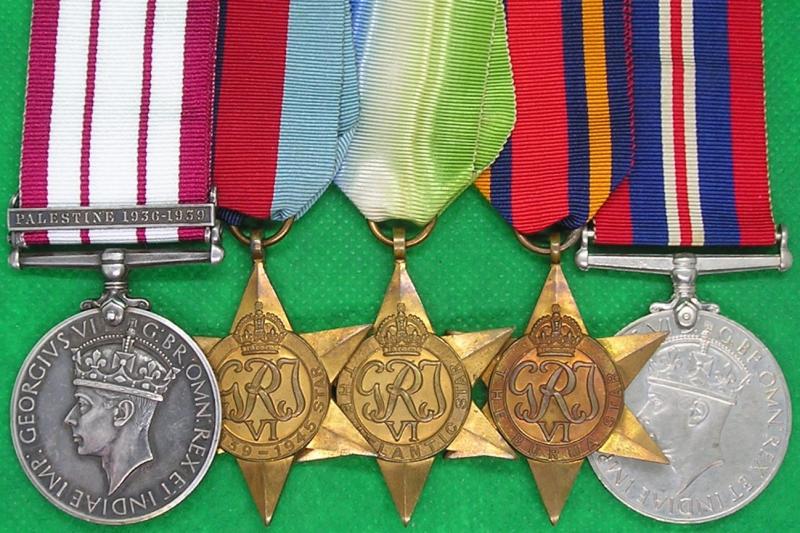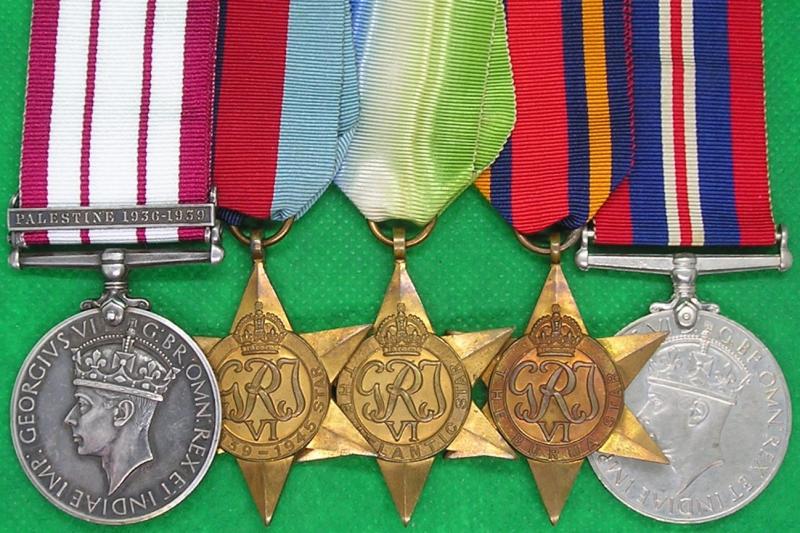WW2 ROYAL NAVY CASUALTY GROUP WITH NGS PALESTINE 1936-39, KIA WITH THE LOSS OF THE SS.KHEDIVE ISMAIL 12-2-1944
GVIR 1st type NGS 1915-1962 With Palestine 1936-39 Clasp, 1939-45 Star, Atlantic star, Burma Star & 1939-45 War Medal
To- D/SSX.22054.J.BANKS.AB.RN
James Banks was on the books of HMS Afrikander but was serving onboard the SS.Khedive Ismail when she was sunk by a Japanese U-Boat 12-2-1944.
On 5 February 1944 Khedive Ismail left Mombasa bound for Colombo carrying 1,348 passengers including 996 members of the East African Artillery's 301st Field Regiment, 271 Royal Navy personnel, 19 WRNS, 53 nursing sisters and their matron, nine members of the First Aid Nursing Yeomanry and a war correspondent, Kenneth Gandar-Dower. She was part of Convoy KR 8 and it was her fifth convoy on that route. The convoy was escorted by the heavy cruiser HMS Hawkins and destroyers HMS Paladin and HMS Petard. Khedive Ismail was carrying the Convoy Commodore.
Early in the afternoon of Saturday 12 February, after a week at sea, KR 8 was in the One and a Half Degree Channel south-west of the Maldives. After lunch many of the passengers were below watching an ENSA concert, while others sunbathed on deck. At 1430 hrs the Japanese submarine I-27 had taken position off Khedive Ismail's port side to attack. A lookout sighted I-27's periscope and raised the alarm; Khedive Ismail's DEMS gunners opened fire on the submarine. At the same time I-27's commander, Cdr Toshiaki Fukumura, fired a spread of four torpedoes, two of which hit Khedive Ismail. HMS Petard depth charged, shelled, torpedoed and sank I-27
The troop ship's stern was engulfed in flame and smoke and she sank in three minutes. As the convoy's merchant ships scattered for safety, Paladin lowered boats to rescue survivors and Petard released depth charges. The troop ship had sunk too quickly to launch any lifeboats, but her Carley floats floated free and some survivors were able to board them.
After three patterned releases I-27 was forced to the surface. The two destroyers engaged her with their 4-inch (100 mm) QF Mk 5 main guns and Paladin moved to ram her, but as a Type B1 submarine, she was considerably larger than the destroyer so Petard signalled Paladin to abort the manoeuvre. Paladin therefore took avoiding action but too late, and I-27's hydroplane tore a 15-foot (4.6 m) gash in Paladin's hull.I-27 submerged again and took refuge beneath the survivors. The destruction of a submarine that might sink more ships took precedence over the lives of survivors, so with Paladin out of action Petard resumed the attack with first depth charges, then 4-inch shellfire and finally 21-inch (530 mm) Mk IX torpedoes. The depth charge fuses had to be set to detonate at the most shallow depth, and they killed or wounded many people who had survived the initial sinking. The seventh torpedo finally destroyed I-27, sinking her with all hands. The battle had lasted two and a half hours.Of 1,511 people aboard Khedive Ismail, only 208 men and 6 women survived the sinking and subsequent battle. 1,220 men and 77 women were killed. The sinking was the third largest loss of life from Allied shipping in World War II and the largest loss of servicewomen in the history of the Commonwealth of Nations.
GVF/NEF & Complete with basic details.
Code: 56209
395.00 GBP


